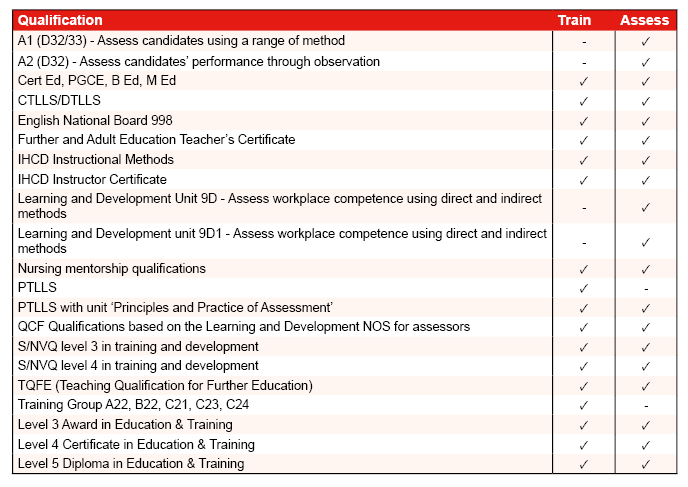When choosing a first aid training provider, you should look for an organisation that has appropriate qualifications, the necessary skills and competencies to deliver training to the required standard, and a quality assurance process. A good supplier should also be able to offer you and your employees the ongoing support required to be fully compliant in your first aid needs.
Since October 2013, however, HSE no longer approves first aid training organisations, meaning that those who were formerly ‘approved’ by HSE to deliver First Aid at Work Training can no longer claim to be. This offers employers more flexibility towards choosing a provider, but it also makes the process of doing so much more complicated.
To help you choose the right first aid training provider for your needs, we have included four key questions you should ask before making your decision.
1. What qualifications should a training provider have?
The individual who delivers the training to your team should have a number of qualifications that show they have the necessary knowledge and competence required to teach first aid, as demonstrated by the list of appropriate qualifications outlined in this HSE information sheet. These include:
- A current, valid First Aid at Work (FAW) certificate, or;
- Registered as a doctor with the General Medical Council
- Registered as a nurse with the Nursing and Midwifery Council
- Registered as a paramedic with the Health and Care Professions Council
A first aid trainer must also have an acceptable training and assessing qualification, examples of which can be found in the table below.

2. Does the training body have the necessary skills/competencies?
Because the HSE no longer officially approves first aid training providers, as a duty holder, you are required to perform due diligence in order to choose a suitable provider.
To find out if the supplier you choose has all the necessary skills and competencies to deliver first aid training to an excellent standard, they will need to be able to demonstrate how they satisfy certain criteria set out by HSE in a due diligence checklist. These criteria include:
- The necessary qualifications expected of trainers and assessors (see table above)
- Monitoring and quality assurance systems in place
- Excellent teaching standards of first-aid practice
- Appropriate syllabus content
- Certification
In addition to these core criteria, according to HSE’s Selecting a First Aid Training Provider: A Guide for Employers (paragraph 23), training organisations should teach the first aid management of injuries and illness in accordance with:
- Current guidelines published by the Resuscitation Council (UK); and
- The current edition of the first-aid manual of the Voluntary Aid Societies, which is co-authored by British Red Cross, St John Ambulance, and St Andrew’s First Aid; or
- Other published guidelines, provided they are in line with the two above or supported by a responsible body of medical opinion.
By satisfying these criteria, you can be sure that the training body you choose are competent to deliver first aid training, helping you to achieve compliance with The Health and Safety (First-Aid) Regulations 1981.
3. What are the provider’s quality assurance processes?
A first aid training provider must be able to provide evidence of a quality assurance process, in which an unbiased designated person (with up to date first aid knowledge and a relevant qualification in assessment) will examine and report on the skills of the trainers - this is to be done annually at the very least.
According to the HSE’s Selecting a First Aid Training Provider: A Guide for Employers, a training provider must also have a documented course evaluation process as part of the quality assurance procedure.
A checklist for evaluating the competence of first aid training organisations can be found below:

4. Does the training provider offer ongoing learning and advice?
As first-aiders are required to attend a yearly requalification course, a good first aid training provider will be able to keep track of your current compliance, and send reminders for yearly and 3-yearly certifications.
At Red Cross Training, we offer your newly trained first-aiders the option to receive a personal login to Safe Hands - our online community where everyone trained by us can read handy guides and watch videos to get the most out of their post-training experience. Our free first aid apps are also available to anyone wanting to know more, which are available on Apple and Android devices.
Why should you choose British Red Cross Training?
As co-authors of the first aid manual of the Voluntary Aid Societies, Red Cross Training are dedicated to providing best practice first aid training. We have training team leaders who observe our first aid trainers every 3 months to ensure that our courses align with best practice, allowing us to deliver the best first aid courses we can.
Additionally, we ask all attendees to provide feedback on each training session, so that we can consistently improve our courses to align with clients’ needs. Our dedicated customer care manager handles all feedback to ensure course quality and customer satisfaction.
Furthermore, as a registered charity, any profits made from our first aid courses (minus running costs) are filtered directly into our humanitarian work. We are the trusted provider used by thousands of UK customers, with more than 40 years' experience delivering first aid courses.
Topics: First Aid


